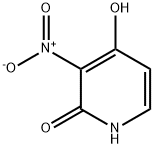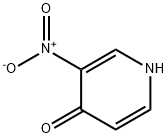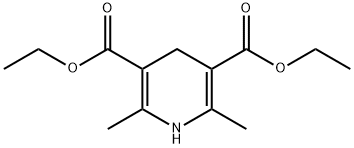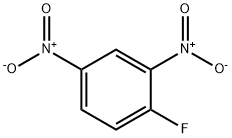2,4-Dihydroxy-3-nitropyridine
- CAS NO.:89282-12-2
- Empirical Formula: C5H4N2O4
- Molecular Weight: 156.1
- MDL number: MFCD01075671
- SAFETY DATA SHEET (SDS)
- Update Date: 2025-07-24 18:13:54

What is 2,4-Dihydroxy-3-nitropyridine?
Chemical properties
Yellow powder
Reactions
2,4-Dihydroxy-3-nitropyridine could be quickly transformed into 5-bromo-2,4-dihydroxy-3-nitropyridine by the action of a solution of bromine. 3.5 g of 2,4-Dihydroxy-3-nitropyridine were heated with a mixture of 1.15 ml of bromine and 30 ml of acetic acid at 70℃ for 15 minutes. When the reaction mixture was cooled with ice, 3.7 g of 5-bromo-2,4-dihydroxy-3-nitropyridine separated out[1]. Yield: 70 %
References
[1] Kolder, C. R. , and H. J. D. Hertog . Migration of halogen atoms in halogeno-derivatives of 2,4-dihydroxypyridine (II). Recueil des Travaux Chimiques des Pays-Bas 72.10(2010):853-858.
Properties of 2,4-Dihydroxy-3-nitropyridine
| Melting point: | 265°C (dec.) |
| Boiling point: | 305.6±42.0 °C(Predicted) |
| Density | 1.65±0.1 g/cm3(Predicted) |
| storage temp. | Inert atmosphere,Room Temperature |
| form | powder to crystal |
| pka | 4.50±1.00(Predicted) |
| color | Light yellow to Yellow to Green |
| BRN | 149558 |
| InChI | InChI=1S/C5H4N2O4/c8-3-1-2-6-5(9)4(3)7(10)11/h1-2H,(H2,6,8,9) |
| CAS DataBase Reference | 89282-12-2(CAS DataBase Reference) |
Safety information for 2,4-Dihydroxy-3-nitropyridine
| Signal word | Warning |
| Pictogram(s) |
 Exclamation Mark Irritant GHS07 |
| GHS Hazard Statements |
H315:Skin corrosion/irritation H319:Serious eye damage/eye irritation H335:Specific target organ toxicity, single exposure;Respiratory tract irritation |
| Precautionary Statement Codes |
P261:Avoid breathing dust/fume/gas/mist/vapours/spray. P264:Wash hands thoroughly after handling. P264:Wash skin thouroughly after handling. P280:Wear protective gloves/protective clothing/eye protection/face protection. P304+P340:IF INHALED: Remove victim to fresh air and Keep at rest in a position comfortable for breathing. P305+P351+P338:IF IN EYES: Rinse cautiously with water for several minutes. Remove contact lenses, if present and easy to do. Continuerinsing. P405:Store locked up. |
Computed Descriptors for 2,4-Dihydroxy-3-nitropyridine
| InChIKey | BKYGVGWYPFVKTK-UHFFFAOYSA-N |
| SMILES | C1(=O)NC=CC(O)=C1[N+]([O-])=O |
2,4-Dihydroxy-3-nitropyridine manufacturer
JSK Chemicals
3Y
Phone:+91-9879767984
Whatsapp: +91-9879767970
product: 2,4-Dihydroxy-3-nitropyridine, 99% 99%
SAKEM LLP
1Y
Phone:+91-9676889998
Whatsapp: +91-9676889998
product: 89282-12-2 2,4-Dihydroxy-3-nitro pyridine 98%
New Products
Indole Methyl Resin tert-butyl 9-methoxy-3-azaspiro[5.5]undecane-3-carboxylate Boc-His(Boc)-OH 2-CTC Resin 4-Chloro-7-tosy1-7Hpyrrolo[2,3-d]pyrimidine 5,7-Dibromo-1H-indole 2,5-dichloro-N-hydroxy-4,6-dimethylpyridine-3-carboximidamide 2,2-Dimethoxy-7-azaspiro[3.5]nonane hydrochloride 4-chloromethyl-5-methyl-1,3-dioxol-2-one (DMDO-Cl) R-2-BENZYLOXY PROPIONIC ACID 1,1’-CARBONYLDIIMIDAZOLE 1,1’-CARBONYLDI (1,2-4 TRIAZOLE) N-METHYL INDAZOLE-3-CARBOXYLIC ACID 4-((2-hydroxyethyl)thio)benzoic acid 1-(TERT-BUTOXYCARBONYL)-2-PYRROLIDINONE Methyl 6-methylnicotinate 3-Pyridineacrylic acid tert-Butyl carbazate TETRAHYDRO-2H-PYRAN-3-OL 2-((4-morpholinophenylamino) (methylthio) methylene) malononitrile 3-(4-morpholinophenylamino)-5-amino-1H-pyrazole-4-carbonitrile 2,4-dihydroxybenzaldehyde 1,3-Diethyl-1,3-Diphenylurea Methyl 2-methylquinoline-6-carboxylateRelated products of tetrahydrofuran








You may like
-
 2,4-Dihydroxy-3-nitropyridine, 99% 99%View Details
2,4-Dihydroxy-3-nitropyridine, 99% 99%View Details
89282-12-2 -
 2,4-Dihydroxy-3-nitropyridine, 98% CAS 89282-12-2View Details
2,4-Dihydroxy-3-nitropyridine, 98% CAS 89282-12-2View Details
89282-12-2 -
 2,4-Dihydroxy-3-nitropyridine CAS 89282-12-2View Details
2,4-Dihydroxy-3-nitropyridine CAS 89282-12-2View Details
89282-12-2 -
 2,4-DIHYDROXY-3-NITROPYRIDINE CAS 89282-12-2View Details
2,4-DIHYDROXY-3-NITROPYRIDINE CAS 89282-12-2View Details
89282-12-2 -
 89282-12-2 2,4-Dihydroxy-3-nitro pyridine 98%View Details
89282-12-2 2,4-Dihydroxy-3-nitro pyridine 98%View Details
89282-12-2 -
 Pyridine 99.5% HPLC /UV SpectroscopyView Details
Pyridine 99.5% HPLC /UV SpectroscopyView Details
110-86-1 -
 Dibutyl PhthalateView Details
Dibutyl PhthalateView Details
84-74-2 -
 Thiourea 99% ARView Details
Thiourea 99% ARView Details
62-56-6
Statement: All products displayed on this website are only used for non medical purposes such as industrial applications or scientific research, and cannot be used for clinical diagnosis or treatment of humans or animals. They are not medicinal or edible.
